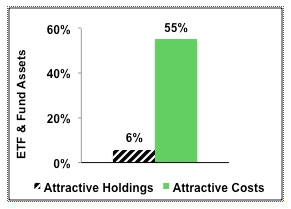Fund holdings affect fund performance more than fees or past performance. A cheap fund is not necessarily a good fund. A fund that has done well in the past is not likely to do well in the future (e.g. 5-star kiss of death and active management has long history of underperformance). Yet, traditional fund research focuses only on low fees and past performance.
Our research on fund holdings enables investors to find funds with high quality holdings – AND – low fees.
Investors are good at picking cheap funds. We want them to be better at picking funds with good stocks. Both are required to maximize success.
Figure 1 shows that 55% of fund assets are in ETFs and mutual funds with low costs but only 6% of assets are in ETFs and mutual funds with Attractive holdings. This discrepancy is astounding.
Figure 1: Allocation of Fund Assets By Holdings Quality and By Costs

Sources: New Constructs, LLC and company filings
Two key shortcomings in the ETF and mutual fund industry cause this large discrepancy:
- A lack of research into the quality of holdings.
- Not enough research focuses on the quality of Portfolio Management of funds
- A lack of high-quality holdings or good stocks in funds.
- With about twice as many funds as stocks in the market, there simply are not enough good stocks to fill all the funds.
These issues are related, in my opinion. If investors had more insight into the quality of funds’ holdings, I think they would allocate a lot less money to funds with poor quality holdings.
Investors deserve research on the quality of stocks held by ETFs and mutual funds.
Quality of holdings is the single most important factor in determining an ETF or mutual fund’s future performance. No matter how low the costs, if the ETF or mutual fund holds bad stocks, performance will be poor. Costs are easy to find but research on the quality of holdings is almost non-existent.
Figure 2 shows investors are not putting enough money into ETFs and mutual funds with high-quality holdings. 502 of 7,364 (6% of assets) of ETFs and mutual funds allocate a significant amount of value to quality holdings. 94% of assets are in funds that do not justify their costs and over charge investors for poor portfolio management.
Figure 2: Distribution of ETFs And Mutual Funds (Count & Assets) By Portfolio Management Rating 
Source: New Constructs, LLC and company filings
Figure 3 shows that Investors successfully find low-cost funds. 55% of assets are held in ETFs and mutual funds that have Attractive-or-better rated Total Annual Costs, my apples-to-apples measure of the all-in cost of investing in any given fund.
Out of the 7,364 ETFs and mutual funds I cover, 1,191 (55% of all assets) earn an Attractive-or-better Total Annual Costs rating.
Clearly, ETF and mutual funds investors are smart shoppers when it comes to finding cheap investments. But cheap is not necessarily good.
Columbia Funds Series Trust: Columbia Mid Cap Index Fund (CIDIX) of a fund with low costs but poor holdings. It gets an overall predictive rating of Dangerous because no matter how low its fees, I expect it to underperform because it holds too many Dangerous-or-worse rated stocks (over 38% of its holdings are rated Dangerous-or-worse). Low fees cannot boost fund performance. Only good stocks can boost performance.
A good example of one these poor holdings is Equinix Inc. (EQIX). It is one of CIDIX’s top five holdings and receives our Very Dangerous rating. In the twelve years of history in our model, EQIX has never achieved positive economic earnings. Just recently, EQIQ began to produce positive net income. However, it still has yet to generate enough after-tax operating profits (NOPAT) to cover its WACC. EQIX is also a very expensive stock. To justify its current stock price ($182.84/share), the company would have to grow its NOPAT at 20%, compounded annually, for eleven years. That is a tall order for any company, but especially for one with such a poor track record of economic earnings. Poor profitability and high expectations make EQIX a Very Dangerous stock.
Figure 3: Distribution of ETFs And Mutual Funds (Count And Assets) By Total Annual Costs Ratings 
Source: New Constructs, LLC and company filings
Investors should allocate their capital to funds with both high-quality holdings and low costs because those are the funds that offer investors the best performance potential.
But they do not. Not even close.
Figure 4 shows that 5% of ETF and mutual fund assets are allocated to funds with low costs and high-quality holdings according to my Predictive Fund Ratings, which are based on the quality of holdings and the all-in costs to investors.
Note the fund industry 2,857 Dangerous-or-worse ETFs and mutual funds compared to just 200 Attractive-or-better ETFs and mutual funds, over 14 times more bad funds than good funds. That means a lot of fees are being paid to managers that do not deserve them.
Figure 4: Distribution of ETFs & Mutual Funds (Count & Assets) By Predictive Ratings 
Source: New Constructs, LLC and company filings
Investors deserve forward-looking ETF and mutual fund research that assesses both costs and quality of holdings. For example, Consumer Staples Select Sector SPDR (XLP) is one of my favorite funds. It earns my Very Attractive rating due to its high quality of holdings (over 72% of its holdings are allocated to Attractive-or-better rated stocks) and low costs (total annual costs of 0.20%).
XLP’s largest holding is The Procter & Gamble Company (PG) (13.54% of net assets). PG earns my Attractive rating. PG has earned positive economic earnings in all fifteen years of history in my model. In 2012, they grew economic earnings by 25%. In exchange for this growth in profits, PG currently sells at 0.97x its economic book value. PG essentially sells at the no-growth value of its operations. Comparing these expectations for future performance to its actual historical performance, PG looks quite cheap. Holding Attractive stocks like PG and charging low costs make XLP a Very Attractive fund
Why is the most popular fund rating system based on backward-looking past performance?
I do not know, but I do know that the lack of transparency into the quality of portfolio management provides cover for the ETF and mutual fund industry to continue to over charge investors for poor portfolio management. How else could they get away with selling over fourteen times more Dangerous-or-worse ETFs and mutual funds than Attractive-or-better?
John Bogle is correct – investors should not pay high fees for active portfolio management. His index funds have provided investors with many low-cost alternatives to actively managed funds.
However, by focusing entirely on costs, he overlooks the primary driver of fund performance: the stocks held by funds.
Research on the quality of portfolio management of funds empower empowers investors to make better investment decisions. Investors should no longer pay for poor portfolio management.
Disclosure: I receive no compensation to write about any specific stock, sector or theme.
